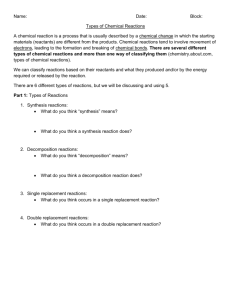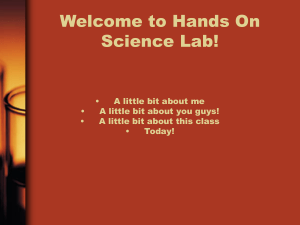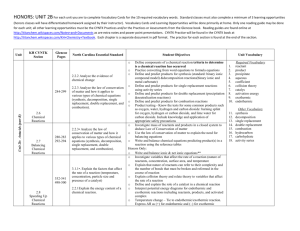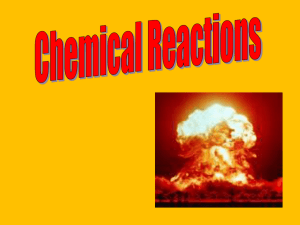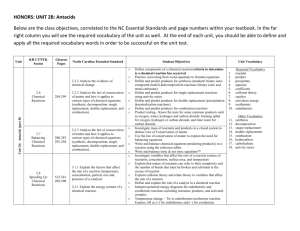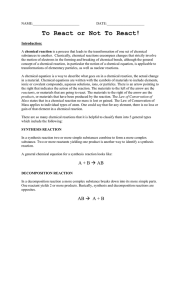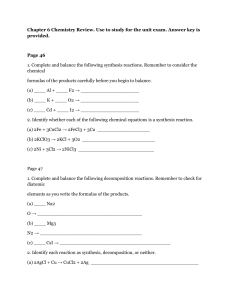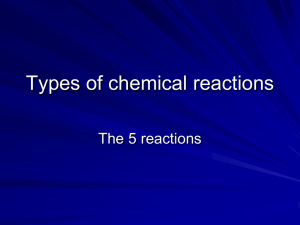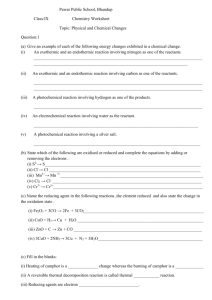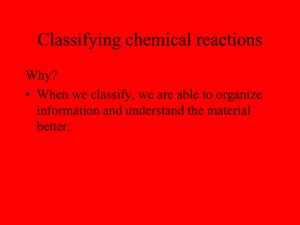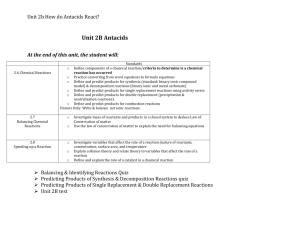Exam B
advertisement
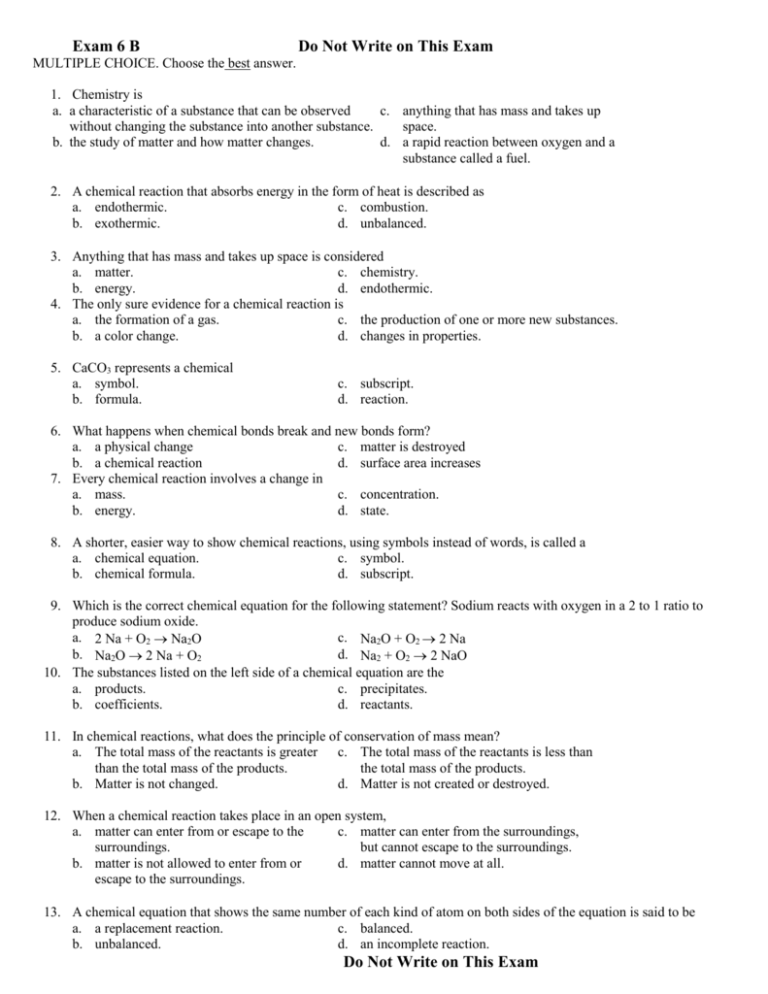
Exam 6 B Do Not Write on This Exam MULTIPLE CHOICE. Choose the best answer. 1. Chemistry is a. a characteristic of a substance that can be observed c. anything that has mass and takes up without changing the substance into another substance. space. b. the study of matter and how matter changes. d. a rapid reaction between oxygen and a substance called a fuel. 2. A chemical reaction that absorbs energy in the form of heat is described as a. endothermic. c. combustion. b. exothermic. d. unbalanced. 3. Anything that has mass and takes up space is considered a. matter. c. chemistry. b. energy. d. endothermic. 4. The only sure evidence for a chemical reaction is a. the formation of a gas. c. the production of one or more new substances. b. a color change. d. changes in properties. 5. CaCO3 represents a chemical a. symbol. b. formula. c. subscript. d. reaction. 6. What happens when chemical bonds break and new bonds form? a. a physical change c. matter is destroyed b. a chemical reaction d. surface area increases 7. Every chemical reaction involves a change in a. mass. c. concentration. b. energy. d. state. 8. A shorter, easier way to show chemical reactions, using symbols instead of words, is called a a. chemical equation. c. symbol. b. chemical formula. d. subscript. 9. Which is the correct chemical equation for the following statement? Sodium reacts with oxygen in a 2 to 1 ratio to produce sodium oxide. a. 2 Na + O2 Na2O c. Na2O + O2 a b. Na2O a + O2 d. Na2 + O2 aO 10. The substances listed on the left side of a chemical equation are the a. products. c. precipitates. b. coefficients. d. reactants. 11. In chemical reactions, what does the principle of conservation of mass mean? a. The total mass of the reactants is greater c. The total mass of the reactants is less than than the total mass of the products. the total mass of the products. b. Matter is not changed. d. Matter is not created or destroyed. 12. When a chemical reaction takes place in an open system, a. matter can enter from or escape to the c. matter can enter from the surroundings, surroundings. but cannot escape to the surroundings. b. matter is not allowed to enter from or d. matter cannot move at all. escape to the surroundings. 13. A chemical equation that shows the same number of each kind of atom on both sides of the equation is said to be a. a replacement reaction. c. balanced. b. unbalanced. d. an incomplete reaction. Do Not Write on This Exam Do Not Write on This Exam 14. The number placed below an element’s symbol in a chemical formula is called a a. coefficient. c. reactant. b. subscript. d. product. 15. The principle of conservation of mass is true a. only for reactions that take place in open systems. c. for reactions in both open and closed systems. b. only for reactions that take place in closed systems. d. for no reactions at all. 16. Which of the following is a balanced chemical equation? a. H2 + O2 H2O c. 2 Mg + HC1 MgCl2 + H2 b. SO2 + O2 + 2 H2O 4 H2SO4 d. 2 Fe2O3 + 3 C 4 Fe + 3 CO2 17. In a chemical equation, numbers often appear in front of a chemical formula. These numbers tell you the a. number of atoms in each molecule in the reaction. c. number of elements in the reaction. b. number of molecules in each atom in the reaction. d. number of molecules or atoms of each substance in the reaction. 18. Which two processes could be considered opposites? a. a decomposition reaction and a c. a precipitate reaction and a synthesis replacement reaction reaction b. a single replacement reaction and a double d. a synthesis reaction and a decomposition replacement reaction reaction 19. What type of reaction is 4Fe + 3O2 2Fe2O3? a. a synthesis reaction c. a single replacement reaction b. a decomposition reaction d. a double replacement reaction 20. Which of the following is NOT a factor that affects the rate of a chemical reaction? a. level of concentration c. the temperature b. amount of surface area d. the mass 21. A bottle of hydrogen peroxide that eventually turns into a bottle of water and oxygen gas (H2O2 H2O + O2) is an example of a a. synthesis reaction. c. replacement reaction. b. decomposition reaction. d. precipitate reaction. 22. Which of the following is NOT an example of a chemical change? a. gas burning on a stove c. salt dissolving in a glass of water b. rust forming on an iron fence d. using electricity to break down water into hydrogen and oxygen 23. The minimum amount of energy that has to be added to start a reaction is the a. exothermic energy. c. activation energy. b. endothermic energy. d. chemical energy. 24. A material used to decrease the rate of a chemical reaction is a(n) a. inhibitor. c. enzyme. b. catalyst. d. fuel. 25. Chemicals that act as biological catalysts by speeding up reactions in living things are a. inhibitors. c. fuels. b. reactants. d. enzymes. 26. One example of a chemical change is a. filtering. c. boiling water. b. burning wood. d. crushing a can. Do Not Write on This Exam
